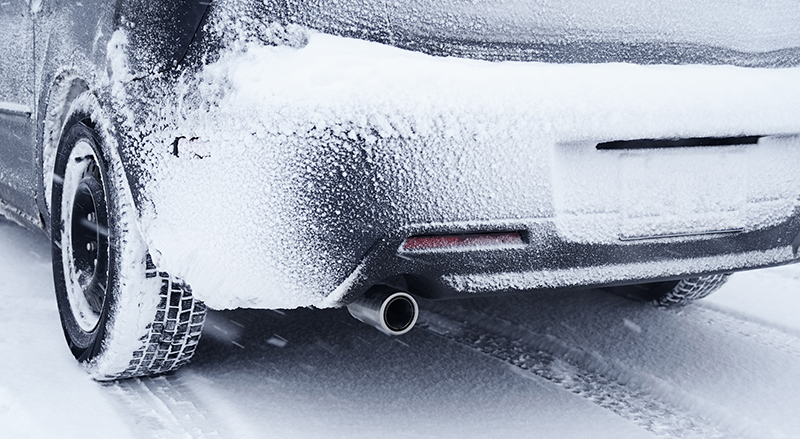Ah, Canadian winters. Majestic to the eye at the best of times, slushy and dirty at the worst of times, and potentially painful for your vehicle at any time. Hard starts don’t help and can exacerbate engine misfires, which can become dangerous if not treated early.
In this blog post, we’ll discuss how Canada’s wintery cold weather contributes to hard starts and misfires.

What Is a Hard Start?
You’ve likely seen at least one scene like this in a movie or TV show: a character needs to drive away fast, but when they turn the key in the ignition, the engine makes a sound that loudly announces, “I’m not going anywhere.” Then, usually bad stuff happens.
That sound indicates a possible hard start.
When you insert your key into the ignition or press the start button, you close an electrical circuit to the starter, which cranks your engine. Your engine should start within two or three seconds. Any longer than that, or if you have to try several times before your engine starts, you have a hard start.
Other signs you’re experiencing a hard start include a rough idle, hesitation when you press the pedal, loss of power, and an illuminated check engine light. (If the check engine light is flashing, you have a severe problem with your engine. Pull over and call roadside assistance.)
Engine hard starts have many causes. For this blog post, we’ll focus on the engine and Canada’s winter climate.
How Does the Cold Affect a Gas-Powered Engine?
Hard starts only happen with gas-powered vehicles. In the combustion chamber, temperatures can reach over 2,200 ˚C. Although reaching this temperature in summer is easy, an engine in winter requires a few minutes to come up to temperature.
When the temperature outside drops, motor oil thickens and therefore flows more slowly through the engine and around the engine block. This puts more strain on the battery to get things moving while it’s already working harder to combat the cold.
What Is a Misfire?
Whereas a hard start affects getting the engine to fire up, a misfire happens when the engine is running. It involves an interruption between the spark and the combustion cycle.
The result is unburned fuel and air passing through the exhaust system and catalytic converter, resulting in increased emissions. In minor—but still undesirable—instances, increased tailpipe emissions are your only issue. However, misfires can cause damage or destroy the catalyst, resulting in high repair costs.
How Does a Misfire Happen?
Many problems can lead to a misfire:
- damage to any component of the ignition system, e.g., spark plugs, ignition coils, spark plug wires
- moisture on ignition components
- fuel system malfunctions that result in either too much or too little air in the engine
- no compression in the cylinder, which means no combustion
Diagnosing your exact problem can be difficult. For example, if it’s a faulty spark plug, switching out all spark plugs for new ones is an easy fix. However, solving decreased compression in the cylinder can require special diagnostic tools, equipment, and expertise.
How Do You Notice an Engine Misfire?
- Strange noises: Your engine may backfire, or you’ll hear a popping or “sneezing” sound.
- Abnormal handling: Your vehicle will feel like it’s stumbling, or you’ll notice a sudden loss of power or a vibration.
- Unpleasant smells: Tailpipe emissions that bypass the catalyst can cause a rotten egg or sulphuric smell. You may also notice a strong gasoline smell, which will emanate from the unburned fuel and air travelling through the exhaust system.
- Illuminated check engine light: Sometimes, your check engine light may signal a benign problem that requires no attention. But don’t ignore it. It can also signal an engine misfiring, which can lead to thousands of dollars in damage.
In short, if your engine is behaving oddly, don’t chalk it up to its age or “personality.” Either inspect your engine yourself or take it to a garage.
You can use an OBD II reader to tell you which cylinder has misfired. Codes for misfires begin with P0300–P0308. (Learn how to choose the best OBD scanner for your needs here.) You can also inspect your spark plugs. If you notice soot or a white deposit on them, switch them out.
Other tests require more detailed steps and specialized equipment.
Hard Starts and Engine Misfires
When the Canadian winter thickens your engine oil and causes a hard start, it can lead to an engine misfire because not enough fuel or air can reach the combustion chamber for complete combustion. If you notice this problem on occasion, it’s probably not an issue. If you notice it often, or if it worsens, check it out.
Questions about engine misfires? Looking for fresh spark plugs? Visit your local NAPA Auto Parts store, and one of our friendly experts will be happy to assist you!




